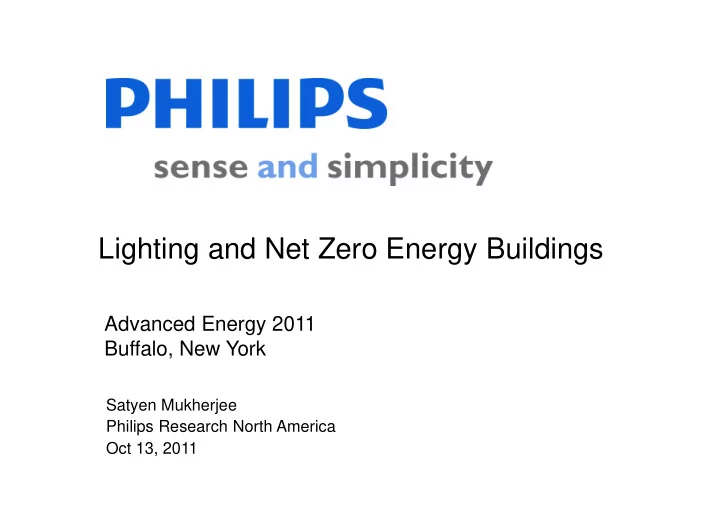

Lighting and Net Zero Energy Buildings Advanced Energy 2011 Buffalo, New York Satyen Mukherjee Philips Research North America Oct 13, 2011
Outline • Why ZEB - Background • Key Challenges • Role of Lighting • Results from DOD test beds • Summary 2 Philips Research North America, Satyen Mukherjee, Oct 13, 2011
U.S. Energy Flow, 2005 (Quads) 86% of primary energy is from fossil fuels, with 69% of the petroleum imported Domestic Supply Consume 67% Fossil 104 100 86% Quads Industrial Quads 32% Imports Nuclear 8% 33% Renewable 6% 3 Philips Research North America, Satyen Mukherjee, Oct 13, 2011 3
Definitions ZEB or ZNEB: Zero Net Energy Building Produces more energy on-site than it consumes, on an annual basis. – Excludes: - Transportation - Embodied Energy in Water, Materials, Waste • Net-zero site energy • Net-zero source energy • Net-zero carbon • Net-zero energy cost Zero Energy Buildings: A Critical Look at the Definition P.Torcellini, S. Pless, M. Deru - NREL D. Crawley - DoE 2006 www.nrel.gov 4 Philips Research North America, Satyen Mukherjee, Oct 13, 2011
Challenges • Wide range of building types • Variability in requirements – geographical, weather • Drift over time • Economic Performance • Flexibility/Adaptability to Changing Needs • Balancing Energy Consumption with Occupant Comfort and Productivity 5 Philips Research North America, Satyen Mukherjee, Oct 13, 2011
Commercial building types 40-90% energy savings needed 6 Philips Research North America, Satyen Mukherjee, Oct 13, 2011
Commercial Buildings Site Electricity Consumption by End Use Lighting +Cooling +Heating +Ventilation = 68% Site Electricity use 7 Philips Research North America, Satyen Mukherjee, Oct 13, 2011
Advanced Lighting Controls: Technology Description OccuSwitch Wireless Dynalite Hybrid ILDC System OccuSwitch Wireless Room-based control Distributed control Room/area based control architecture bldg-wide connectivity with building-wide connectivity Scalability Room by Room Scalable from a single room Scalable from a single to entire building room to wide area control Best Single offices; barracks; New construction, major Multi floor office buildings applications Retrofits; smaller renovation with daylight areas. budget Retrofit or new In-room Wireless based on Wired Wireless based on ZigBee Connectivity ZigBee PRO standard PRO standard Cost +++ Installation + Installation ++ Installation advantage ++ Commissioning +++ Commissioning ++ Commissioning Energy adv. ++ ++ +++ Dynalite Hybrid ILDC 8 Philips Research North America, Satyen Mukherjee, Oct 13, 2011
Building A—Lighting Power Density Weekday pre-retrofit LPD Weekday post-retrofit LPD 1 1 LIghting Power Density (W/sq LIghting Power Density (W/sq ft) 0.9 0.9 Mean 0.8 0.8 0.7 0.7 Mean 0.6 0.6 Mean- 0.5 0.5 Mean-Standard Standard 0.4 ft) 0.4 Deviation Deviation 0.3 0.3 0.2 Mean+Standard Mean+Standar 0.2 0.1 Deviation d Deviation 0.1 0 0 0 6 12 18 24 0 6 12 18 24 Time of day Time of day Pre-retrofit weekday EUI distribution Pre-retrofit weekday EUI distribution Percent of weekday EUIs Percent of weekday EUIs 16% 45% 14% 40% 35% 12% in each bin in each bin 30% 10% 25% 8% 20% 6% 15% 4% 10% 2% 5% 0% 0% 0 1 2 3 4 5 6 7 8 9 10 0 1 2 3 4 5 6 7 8 9 10 Energy Use Intensity Bins (W-h/sq ft/day) Energy Use Intensity Bins (W-h/sq ft/day) Weekday LPD decreased deeply throughout the day. 9 Philips Research North America, Satyen Mukherjee, Oct 13, 2011
Preliminary Performance Summary – June 2011 Building A: Hybrid ILDC – Area covered 1782 sq.ft. Code Post- Reduction compared Performance objective baseline retrofit to code baseline Annual EUI (kWh/sq ft/yr) 4.54 0.82 82% Peak LPD over a 15 minute period (W/sq ft) 1.81 0.64 65% Average deviation from specified illuminance range (lux) N/A 1N/A Building B: Occuswitch - Area Covered 4821 sq.ft. Code Post- Reduction compared Performance objective baseline retrofit to code baseline Annual EUI (kWh/sq ft/yr) 4.54 1.74 62% Peak LPD over a 15 minute period (W/sq ft) 1.81 0.9 50% Average deviation from specified illuminance range (lux) N/A 40N/A Building C: Dynalite – Area Covered 6450 sq.ft. Code Post- Reduction compared Performance objective baseline retrofit to code baseline Annual EUI (kWh/sq ft/yr) 4.54 2.90 36% Peak LPD over a 15 minute period (W/sq ft) 1.81 0.82 55% Average deviation from specified illuminance range (lux) N/A to come N/A 10 Philips Research North America, Satyen Mukherjee, Oct 13, 2011
11 Philips Research North America, Satyen Mukherjee, Oct 13, 2011
Index Integrated Solution Lighting Architectural Blinds Audio Visual Dynet Security Ventilation Air Conditioning Access Heating 12 Philips Research North America, Satyen Mukherjee, Oct 13, 2011
NZEB around the Globe East Asia Massachusetts, USA Florida, USA, both source and emissions NZEB, 2010 Singapore planned 2009 Colorado USA NREL, USA, 2011 educational 13 Philips Research North America, Satyen Mukherjee, Oct 13, 2011
The opportunity space Thank You Show the power of conservation by demonstrating conservation of power 14 Philips Research North America, Satyen Mukherjee, Oct 13, 2011
Recommend
More recommend